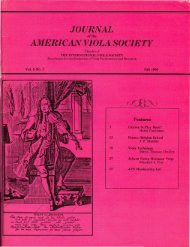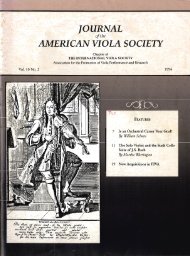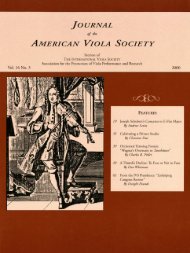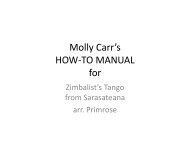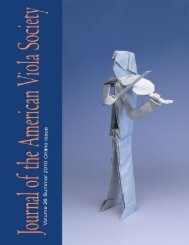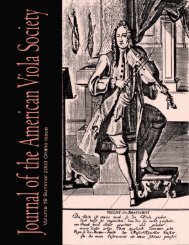Summer 2013 - The American Viola Society
Summer 2013 - The American Viola Society
Summer 2013 - The American Viola Society
You also want an ePaper? Increase the reach of your titles
YUMPU automatically turns print PDFs into web optimized ePapers that Google loves.
Musical Sources<br />
<strong>The</strong> Trio was published by Ediciones Mexicanas de Música (score and parts). 4 <strong>The</strong>re are also three<br />
manuscript scores that will be referred to as MS1, MS2, and MS3. 5 MS1 and MS2 were written by<br />
Ponce in pencil and ink, respectively. MS3 is a handmade copy of MS2 signed by Pineda and<br />
includes parts. MS1 is the earlier draft (ex. 1) and MS2 a cleaner version (exs. 2–11). MS1–MS3<br />
contain two cello parts: one easy and the other more elaborated. 6 <strong>The</strong> latter is used in the printed<br />
edition.<br />
An Unusual Case<br />
<strong>The</strong> piece was born under very particular circumstances. <strong>The</strong> sixty-year-old composer wrote it for a<br />
six-year-old boy and his parents, a family of amateur musicians. <strong>The</strong> dedication in the sources<br />
varies. <strong>The</strong> printed edition reads: “For Cécile, Carlos, and Carlitos Prieto.” In MS1: “For Cécile,<br />
Carlos, and Carlitos Prieto (a six-year-old cellist).” And in MS2: “For Cécile, Carlos, and Carlitos<br />
Prieto (a six-year-old cellist) who someday will surely be able to play the non-facilitated cello part.<br />
Cordially, Manuel M. Ponce, Mexico, 4 November 1943.” 7 Indeed, Carlos Prieto Jacqué is not only<br />
among Mexico’s most distinguished musicians but also a successful author and engineer. 8<br />
<strong>The</strong> Prieto Family 9<br />
Carlos Prieto Fernández de la Llana was a lawyer, and Cécile Jacqué was a homemaker. Although<br />
Cécile’s parents were from France, both she and Carlos were born in Spain, married there, and later<br />
became Mexican citizens. <strong>The</strong>y were high-level amateur performers, each playing the violin and the<br />
viola; Carlos specialized in the former and Cécile in the latter. She studied in the Schola Cantorum<br />
of Paris.<br />
<strong>The</strong> Prietos were close friends and admirers of Ponce. <strong>The</strong>y loved both the Sonate en duo pour<br />
violon et alto (1938) 10 as well as the string trio that the artist dedicated to them and frequently<br />
performed these pieces in family gatherings. Both compositions have a Spanish flair, most likely in<br />
honor of the dedicatees.<br />
<strong>The</strong>y were a very musical family; Cécile’s father played the viola and her brother the cello.<br />
Together with Carlos and Cécile, they formed a string quartet. Later on, Carlos Jr. became the<br />
cellist of the group. His younger brother, Juan Luis, who played violin, joined the ensemble and<br />
Cécile occupied the position of violist. <strong>The</strong> quartet continued with Carlos Jr.’s son, Carlos Miguel, 11<br />
and nephew, Juan Luis, both violinists. Another distinguished member of the family was Carlos<br />
Sr.’s sister, María Teresa Prieto, 12 a composer who at some point took lessons from Ponce.<br />
A Note of History<br />
In MS1 (ex. 1) one can notice that Ponce created the piece with the easy cello part first and later<br />
appended the more elaborated one. In some cases he adds an extra staff (systems 1–3). In other<br />
instances, the advanced part is written over the simple one (systems 4–5).<br />
VOLUME 29 SUMMER <strong>2013</strong> ONLINE ISSUE<br />
27



